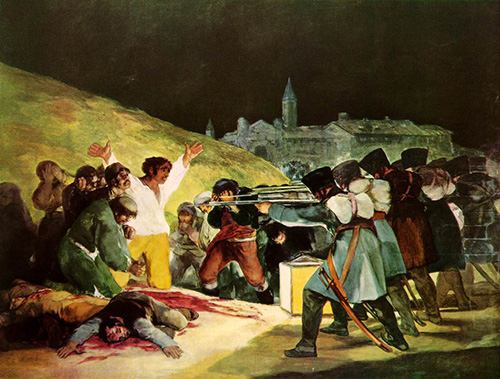Just for reference - -

The Third of May, Francisco de Goya, 1808

Barack Obama, Kehinde Wiley, 2018


Par for the course. Trump fans are resistant to thinking for themselves or coming up with their own material.
I can buy the parody angle. It still does seem lazy, though.Doctor CamNC4Me wrote: ↑Wed Feb 15, 2023 4:31 pmI think of those examples as less of a plagiarism and more of a parody. For example, within the Trump cult they really, really did not like the Obama portrait. In their minds it didn’t look right, whatever that means to them. So when this brainwashed psycho painted Biden in the manner he did, it was a call back to that - his audience knew he was mocking the Obama portrait.
- Doc
Parody particularly for the Biden portrait as you explain. Reinterpretation to communicate as with the Goya painting is well within accepted practice. That is about as much good to say about this work as I can cobble together.Doctor CamNC4Me wrote: ↑Wed Feb 15, 2023 4:31 pmI think of those examples as less of a plagiarism and more of a parody. For example, within the Trump cult they really, really did not like the Obama portrait. In their minds it didn’t look right, whatever that means to them. So when this brainwashed psycho painted Biden in the manner he did, it was a call back to that - his audience knew he was mocking the Obama portrait.
- Doc
It’s odd looking, but it’s actually supposed to be a lantern. The Wiki page on this painting includes an interesting bit about that element of the scene:huckelberry wrote: ↑Thu Feb 16, 2023 10:47 pmI was looking at the Goya and thought Jon could learn something about black there. Jon's blacks are weak and unpleasant while Goya can do gorgeous dramatic black. Well maybe such things are outside of Jon's intentions.
But I realized I have long , without much thought considered the light glare in Goya's work to be imagination, artistic license. But I see I have been lazy in looking. The light is carefully understood to come from the weird box in the center of the picture. What is that? imagination? Perhaps it is an early gaslight and the picture is under the glare of then early modern lighting. The glare of an oncoming future.
The painting is structurally and thematically tied to traditions of martyrdom in Christian art, as exemplified in the dramatic use of chiaroscuro, and the appeal to life juxtaposed with the inevitability of imminent execution. However, Goya's painting departs from this tradition. Works that depicted violence, such as those by Jusepe de Ribera, feature an artful technique and harmonious composition which anticipate the "crown of martyrdom" for the victim. The man with raised arms at the focal point of the composition has often been compared to a crucified Christ, and a similar pose is sometimes seen in depictions of Christ's nocturnal Agony in the Garden of Gethsemane. Goya's figure displays stigmata-like marks on his right hand, while the lantern at the center of the canvas references a traditional attribute of the Roman soldiers who arrested Christ in the garden. Not only is he posed as if in crucifixion, he wears yellow and white: the heraldic colors of the papacy.
Giovanni Battista Tiepolo's 1722 St. Bartholomew is a traditional scene of martyrdom, with the saint beseeching God. Goya drew inspiration from the iconography of such violent scenes.
The lantern as a source of illumination in art was widely used by Baroque artists, and perfected by Caravaggio. Traditionally a dramatic light source and the resultant chiaroscuro were used as metaphors for the presence of God. Illumination by torch or candlelight took on religious connotations; but in The Third of May the lantern manifests no such miracle. Rather, it affords light only so that the firing squad may complete its grim work, and provides a stark illumination so that the viewer may bear witness to wanton violence. The traditional role of light in art as a conduit for the spiritual has been subverted.